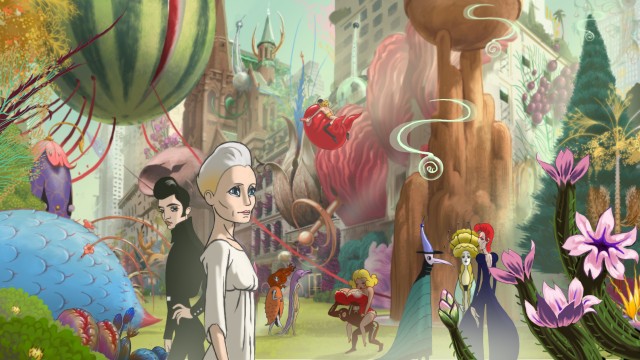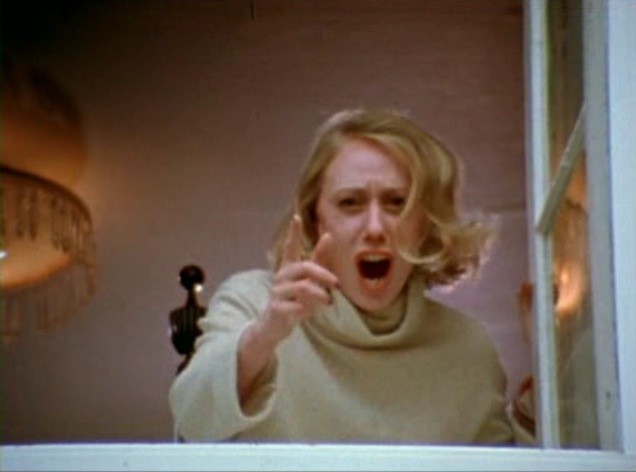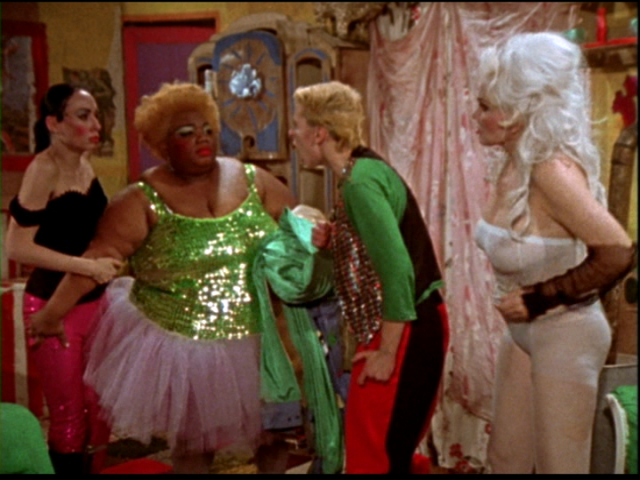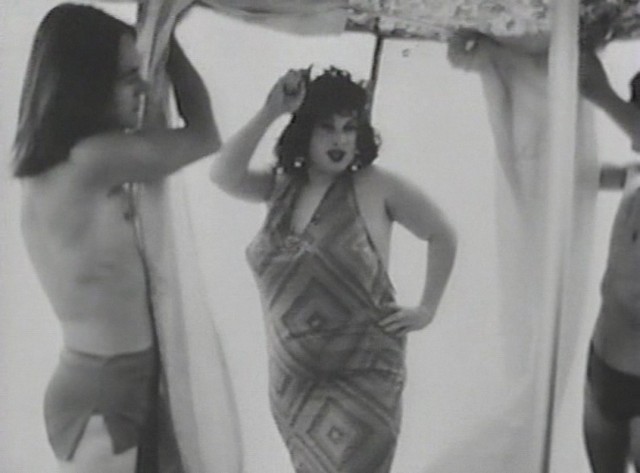
Divine is the star of “Cavalcade of Perversions” in John Waters’s splendidly lurid MULTIPLE MANIACS
MULTIPLE MANIACS (John Waters, 1970), THE DIANE LINKLETTER STORY (John Waters, 1970), and MONDO TRASHO (John Waters, 1969)
Film Society of Lincoln Center, Francesca Beale Theater, Elinor Bunin Munroe Film Center
144 West 65th St. between Eighth Ave. & Broadway
Thursday, September 11, $25 (standby only) 7:00
Series runs September 5-14
212-875-5050
www.filmlinc.com
 The awesomely titled Film Society of Lincoln Center complete retrospective “Fifty Years of John Waters: How Much Can You Take?” was probably primarily inspired by the fabulously titled September 11 program “Celluloid Atrocity Night!” That evening includes three of the Baltimore-born auteur’s craziest early works, hailing from 1969-70, when the King of Bad Taste, serving as writer, director, producer, cinematographer, and editor, was in his early twenties. The triple feature kicks off with the extremely low budget romp Multiple Maniacs, which begins with barker Mr. David (David Lochary) inviting people into “Lady Divine’s Cavalcade of Perversions,” proclaiming, “This is the show you want. . . . the sleaziest show on earth. Not actors, not paid imposters, but real, actual filth who have been carefully screened in order to present to you the most flagrant violation of natural law known to man.” Of course, that serves as the perfect introduction to the cinematic world of John Waters, one dominated by the celebration of sexual proclivities, fetish, salaciousness, indecency, violence, and marginalized weirdos living on the fringes of society. Lady Divine, played by Divine, turns out to be a cheat, the freak show just a set-up for a robbery. Soon Divine is jealous of David’s relationship with Bonnie (Mary Vivian Pearce), hanging out with her topless daughter, Cookie (Cookie Mueller), and being led into a church by the Infant of Prague (Michael Renner Jr.), where she’s brought to sexual ecstasy by Mink (Mink Stole). There’s also rape, murder, Jesus (George Figgs), the Virgin Mary (Edith Massey), and the famed Lobstura. Shot in lurid black-and-white, Multiple Maniacs is a divine freak show all its own, an underground classic that redefined just what a movie could be, a crude, disturbing tale that you can’t turn away from.
The awesomely titled Film Society of Lincoln Center complete retrospective “Fifty Years of John Waters: How Much Can You Take?” was probably primarily inspired by the fabulously titled September 11 program “Celluloid Atrocity Night!” That evening includes three of the Baltimore-born auteur’s craziest early works, hailing from 1969-70, when the King of Bad Taste, serving as writer, director, producer, cinematographer, and editor, was in his early twenties. The triple feature kicks off with the extremely low budget romp Multiple Maniacs, which begins with barker Mr. David (David Lochary) inviting people into “Lady Divine’s Cavalcade of Perversions,” proclaiming, “This is the show you want. . . . the sleaziest show on earth. Not actors, not paid imposters, but real, actual filth who have been carefully screened in order to present to you the most flagrant violation of natural law known to man.” Of course, that serves as the perfect introduction to the cinematic world of John Waters, one dominated by the celebration of sexual proclivities, fetish, salaciousness, indecency, violence, and marginalized weirdos living on the fringes of society. Lady Divine, played by Divine, turns out to be a cheat, the freak show just a set-up for a robbery. Soon Divine is jealous of David’s relationship with Bonnie (Mary Vivian Pearce), hanging out with her topless daughter, Cookie (Cookie Mueller), and being led into a church by the Infant of Prague (Michael Renner Jr.), where she’s brought to sexual ecstasy by Mink (Mink Stole). There’s also rape, murder, Jesus (George Figgs), the Virgin Mary (Edith Massey), and the famed Lobstura. Shot in lurid black-and-white, Multiple Maniacs is a divine freak show all its own, an underground classic that redefined just what a movie could be, a crude, disturbing tale that you can’t turn away from.
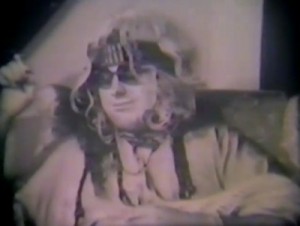
Divine plays Diane Linkletter on the day of her suicide in John Waters’s wicked short
On October 4, 1969, Diane Linkletter, the twenty-year-old daughter of television personality Art Linkletter (Kids Say the Darndest Things) and his wife, Lois Foerster, committed suicide. The next day, her father announced that it was Diane’s use of LSD that killed her, and he soon became a virulent right-wing antidrug crusader. Also on October 5, John Waters made the nine-minute The Diane Linkletter Story, an improvised fictional dramatization of Diane’s suicide, with Lochary as Art, Pearce as Lois, and Divine as Diane. The short begins and ends with snippets of the real Art and Diane’s Grammy-winning spoken-word record “We Love You, Call Collect”; in between, Divine acts up a storm as a defiant drug-loving hippie standing up to her white-bread parents. Is the film a mean-spirited attack in horrifically bad taste? A clarion call for the youth of America to continue their revolt against squares? Just an experiment for a group of friends exploring the boundaries of cinema? You decide.
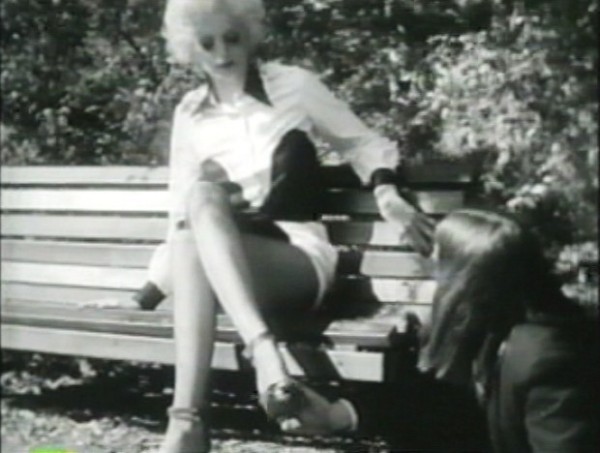
Prince Charming has a thing for a blonde bombshell’s feet in MONDO TRASHO
The Waters hat trick concludes with 1969’s truly bizarre Mondo Trasho, a freestyle foray into fast cars, foot fetishism, and severely fractured fairy tales. Pearce stars as a Cinderella-like blonde woman whose feet are attacked by Prince Charming (John Leisenring, who also plays the Shrimper) in a park. Later she is accidentally run down by Divine driving a cherry 1959 Cadillac Eldorado convertible as the story turns into a freak noir / 1950s rock-and-roll movie. There is minimal dialogue; instead, Waters fills the film with a ricocheting cacophony of R&B, rock, classical, doo wop, gospel, opera, show tunes, and more that fly by like a chicken without its head. (Beware of the opening scene, when that’s just what happens.) Much of Mondo Trasho is hard to watch, and very little of it makes any sense, but there’s something endearing about its madness, although it won’t seem nearly as sick and twisted to those familiar with the work of Kenneth Anger and Jack Smith. (Well, actually, perhaps it still will.) Waters made the film for a mere two grand, and it features his regular troupe, including Lochary as Dr. Coathanger and Susan Lowe, George Figgs, and Mink Stole as asylum inmates (and other characters), while taking on authority, the medical community, conventional society, religion, and even cinema itself. The screenings will be followed by a conversation with Waters moderated by Dennis Dermody. The series continues through September 14 and features all of Baltimore’s favorite son’s shorts and full-length movies in addition to “Movies I’m Jealous I Didn’t Make,” eight films that Waters says are “extreme, astoundingly perverse, darkly funny, and, most importantly, supremely surprising films that turn me green with envy.”
 New York City-born French filmmaker Eugène Green equates humanity and architecture in the lush, rich film La Sapienza. Named for the concept of gaining wisdom as well as Italian architect Francesco Borromini’s seventeenth-century Roman Catholic Baroque church Sant’Ivo alla Sapienza, the film follows an older couple who rediscover their personal and professional passion after meeting a young pair of siblings. Architect Alexandre Schmidt (Fabrizio Rongione) and his wife, sociologist Aliénor (Christelle Prot Landman), are walking through a park in Switzerland when they see a teenage girl (Arianna Nastro) nearly collapse into the arms of a slightly older boy (Ludovico Succio). It turns out that Lavinia is suffering from incapacitating dizzy spells and is cared for by her brother, Goffredo, who is interested in studying architecture. Aliénor becomes involved in Lavinia’s situation while Alexandre, an intense, cynical man, returns to the book he is writing on Borromini (who famously worked in the shadow of Bernini) and travels to Italy with Goffredo as the boy’s reluctant mentor. Green’s (Toutes les nuits, Le monde vivant) first digital feature opens with the glorious sounds of Claudio Monteverdi accompanying cinematographer Raphaël O’Byrne’s magisterial shots of statuary and architecture in Rome. The acting at the start, particularly Rongione’s, is purposefully stiff and mannered, cold and stonelike, but it warms up as the characters learn (or relearn) about the myriad possibilities life offers. Green uses the metaphor of Baroque architecture’s role in the Counter-Reformation as a symbol for Alexandre and Aliénor’s relationship, as they finally face long-held emotions and reconsider their future, all while Green lingers on magnificent structures. La Sapienza will have its U.S. premiere at the New York Film Festival on September 27 at 3:00 and September 28 at 12:15; both screenings will be followed by a Q&A with Green, who also appears in the film as the grizzled Chaldean.
New York City-born French filmmaker Eugène Green equates humanity and architecture in the lush, rich film La Sapienza. Named for the concept of gaining wisdom as well as Italian architect Francesco Borromini’s seventeenth-century Roman Catholic Baroque church Sant’Ivo alla Sapienza, the film follows an older couple who rediscover their personal and professional passion after meeting a young pair of siblings. Architect Alexandre Schmidt (Fabrizio Rongione) and his wife, sociologist Aliénor (Christelle Prot Landman), are walking through a park in Switzerland when they see a teenage girl (Arianna Nastro) nearly collapse into the arms of a slightly older boy (Ludovico Succio). It turns out that Lavinia is suffering from incapacitating dizzy spells and is cared for by her brother, Goffredo, who is interested in studying architecture. Aliénor becomes involved in Lavinia’s situation while Alexandre, an intense, cynical man, returns to the book he is writing on Borromini (who famously worked in the shadow of Bernini) and travels to Italy with Goffredo as the boy’s reluctant mentor. Green’s (Toutes les nuits, Le monde vivant) first digital feature opens with the glorious sounds of Claudio Monteverdi accompanying cinematographer Raphaël O’Byrne’s magisterial shots of statuary and architecture in Rome. The acting at the start, particularly Rongione’s, is purposefully stiff and mannered, cold and stonelike, but it warms up as the characters learn (or relearn) about the myriad possibilities life offers. Green uses the metaphor of Baroque architecture’s role in the Counter-Reformation as a symbol for Alexandre and Aliénor’s relationship, as they finally face long-held emotions and reconsider their future, all while Green lingers on magnificent structures. La Sapienza will have its U.S. premiere at the New York Film Festival on September 27 at 3:00 and September 28 at 12:15; both screenings will be followed by a Q&A with Green, who also appears in the film as the grizzled Chaldean.
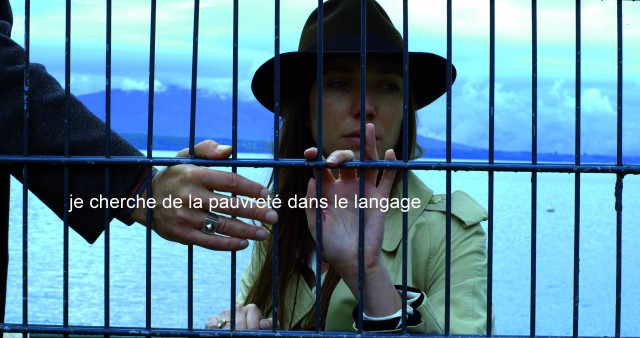
 After the New York Film Festival advance press screening of Jean-Luc Godard’s 3D Goodbye to Language, a colleague turned to me and said, “If this was Godard’s first film, he would never have had a career.” While I don’t know whether that might be true, I do know that Goodbye to Language is the 3D flick Godard was born to make, a 3D movie that couldn’t have come from anyone else. What’s it about? I have no idea. Well, that’s not exactly right. It’s about everything, and it’s about nothing. It’s about the art of filmmaking. It’s about the authority of the state and freedom. It’s about extramarital affairs. It’s about seventy minutes long. It’s about communication in the digital age. (Surprise! Godard does not appear to be a fan of the cell phone and Yahoo!) And it’s about a cute dog (which happens to be his own mutt, Miéville, named after his longtime partner, Anne-Marie Miéville). In the purposefully abstruse press notes, Godard, now eighty-three, describes it thusly: “the idea is simple / a married woman and a single man meet / they love, they argue, fists fly / a dog strays between town and country / the seasons pass / the man and woman meet again / the dog finds itself between them / the other is in one / the one is in the other / and they are three / the former husband shatters everything / a second film begins / the same as the first / and yet not / from the human race we pass to metaphor / this ends in barking / and a baby’s cries.” Yes, it’s all as simple as that. Or maybe not.
After the New York Film Festival advance press screening of Jean-Luc Godard’s 3D Goodbye to Language, a colleague turned to me and said, “If this was Godard’s first film, he would never have had a career.” While I don’t know whether that might be true, I do know that Goodbye to Language is the 3D flick Godard was born to make, a 3D movie that couldn’t have come from anyone else. What’s it about? I have no idea. Well, that’s not exactly right. It’s about everything, and it’s about nothing. It’s about the art of filmmaking. It’s about the authority of the state and freedom. It’s about extramarital affairs. It’s about seventy minutes long. It’s about communication in the digital age. (Surprise! Godard does not appear to be a fan of the cell phone and Yahoo!) And it’s about a cute dog (which happens to be his own mutt, Miéville, named after his longtime partner, Anne-Marie Miéville). In the purposefully abstruse press notes, Godard, now eighty-three, describes it thusly: “the idea is simple / a married woman and a single man meet / they love, they argue, fists fly / a dog strays between town and country / the seasons pass / the man and woman meet again / the dog finds itself between them / the other is in one / the one is in the other / and they are three / the former husband shatters everything / a second film begins / the same as the first / and yet not / from the human race we pass to metaphor / this ends in barking / and a baby’s cries.” Yes, it’s all as simple as that. Or maybe not.
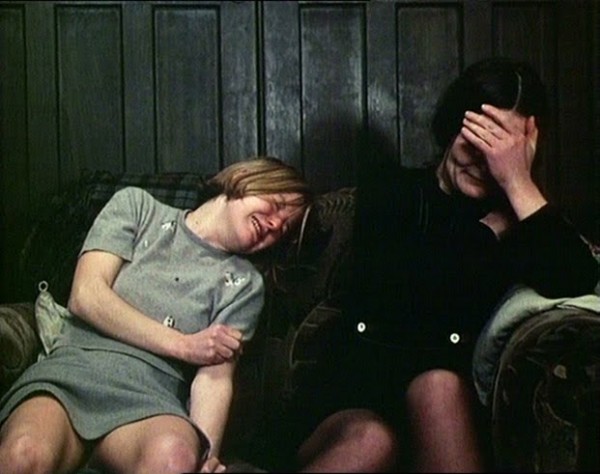
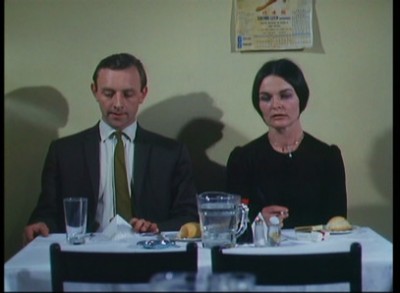
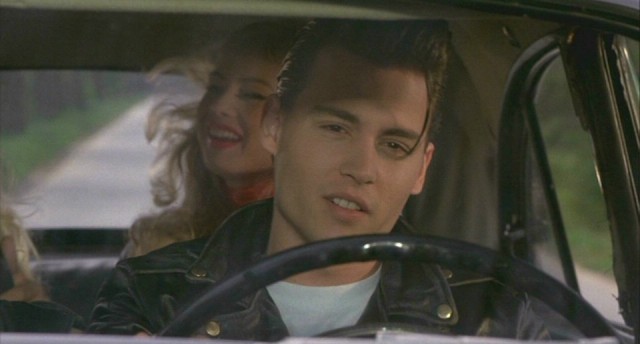
 It’s the drapes versus the squares as Grease and Rebel without a Cause meet West Side Story and Jailhouse Rock in one of trash king John Waters’s most accessible films, the romantic musical comedy Cry-Baby. Waters snatched 21 Jump Street heartthrob Johnny Depp right off the covers of teen magazines for his first starring role in a feature film, with Depp playing high school heartthrob and leather-jacketed bad boy Wade “Cry-Baby” Walker, leader of the rough-and-tough drapes, who also include his pregnant sister, Pepper (Ricki Lake), the trampy Wanda Woodward (porn star Traci Lords), Mona “Hatchet-Face” Malnorowski (Kim McGuire), and Milton Hackett (Darren E. Burrows). Lenora Frigid (Kim Webb) is desperate to go out with Cry-Baby, who earned his nickname because of the solitary tear that can trickle from one of his eyes, but he has his sights set on square queen Allison Vernon-Williams (Amy Locane), whose grandmother (Polly Bergen) runs a charm school and is disgusted by the juvenile delinquents. She much prefers Allison stay true to nerd king Baldwin (Stephen Mailer) than hang out with the dregs of society. But Allison and Cry-Baby’s love just might be meant to be. Writer-director Waters wonderfully evokes 1950s teen flicks with fast cars, the pangs of first love, and a delicious soundtrack of old and new tunes as Cry-Baby and Baldwin fight it out onstage in song instead of with knives or other weapons. (James Intveld sings Depp’s part, while Rachel Sweet does Allison’s.) Waters has also assembled a cast of parents to end all casts of parents: Troy Donahue and Mink Stole are Mr. and Mrs. Malnorowski, Joe Dallesandro and Joey Heatherton are Mr. and Mrs. Hackett, David Nelson and Patricia Hearst are Mr. and Mrs. Woodward, and Iggy Pop and Susan Tyrell are Mr. and Mrs. Rickettes. The story doesn’t always hold together, but Depp easily gets things back on track with his damn fine looks — er, charismatic performance. And yes, that prison guard is indeed Willem Dafoe. Cry-Baby, which was turned into a Broadway musical that earned four Tony nominations but had a very short run at the Marquis Theatre, is screening September 13 at 3:00 and September 14 at 8:00 as part of the spectacularly titled Film Society of Lincoln Center series “Fifty Years of John Waters: How Much Can You Take?” The series runs through September 14 and features all of Baltimore’s favorite son’s shorts and full-length works in addition to “Movies I’m Jealous I Didn’t Make,” eight films that Waters says are “extreme, astoundingly perverse, darkly funny, and, most importantly, supremely surprising films that turn me green with envy.
It’s the drapes versus the squares as Grease and Rebel without a Cause meet West Side Story and Jailhouse Rock in one of trash king John Waters’s most accessible films, the romantic musical comedy Cry-Baby. Waters snatched 21 Jump Street heartthrob Johnny Depp right off the covers of teen magazines for his first starring role in a feature film, with Depp playing high school heartthrob and leather-jacketed bad boy Wade “Cry-Baby” Walker, leader of the rough-and-tough drapes, who also include his pregnant sister, Pepper (Ricki Lake), the trampy Wanda Woodward (porn star Traci Lords), Mona “Hatchet-Face” Malnorowski (Kim McGuire), and Milton Hackett (Darren E. Burrows). Lenora Frigid (Kim Webb) is desperate to go out with Cry-Baby, who earned his nickname because of the solitary tear that can trickle from one of his eyes, but he has his sights set on square queen Allison Vernon-Williams (Amy Locane), whose grandmother (Polly Bergen) runs a charm school and is disgusted by the juvenile delinquents. She much prefers Allison stay true to nerd king Baldwin (Stephen Mailer) than hang out with the dregs of society. But Allison and Cry-Baby’s love just might be meant to be. Writer-director Waters wonderfully evokes 1950s teen flicks with fast cars, the pangs of first love, and a delicious soundtrack of old and new tunes as Cry-Baby and Baldwin fight it out onstage in song instead of with knives or other weapons. (James Intveld sings Depp’s part, while Rachel Sweet does Allison’s.) Waters has also assembled a cast of parents to end all casts of parents: Troy Donahue and Mink Stole are Mr. and Mrs. Malnorowski, Joe Dallesandro and Joey Heatherton are Mr. and Mrs. Hackett, David Nelson and Patricia Hearst are Mr. and Mrs. Woodward, and Iggy Pop and Susan Tyrell are Mr. and Mrs. Rickettes. The story doesn’t always hold together, but Depp easily gets things back on track with his damn fine looks — er, charismatic performance. And yes, that prison guard is indeed Willem Dafoe. Cry-Baby, which was turned into a Broadway musical that earned four Tony nominations but had a very short run at the Marquis Theatre, is screening September 13 at 3:00 and September 14 at 8:00 as part of the spectacularly titled Film Society of Lincoln Center series “Fifty Years of John Waters: How Much Can You Take?” The series runs through September 14 and features all of Baltimore’s favorite son’s shorts and full-length works in addition to “Movies I’m Jealous I Didn’t Make,” eight films that Waters says are “extreme, astoundingly perverse, darkly funny, and, most importantly, supremely surprising films that turn me green with envy.
 The awesomely titled Film Society of Lincoln Center complete retrospective “Fifty Years of John Waters: How Much Can You Take?” was probably primarily inspired by the fabulously titled September 11 program “Celluloid Atrocity Night!” That evening includes three of the Baltimore-born auteur’s craziest early works, hailing from 1969-70, when the King of Bad Taste, serving as writer, director, producer, cinematographer, and editor, was in his early twenties. The triple feature kicks off with the extremely low budget romp Multiple Maniacs, which begins with barker Mr. David (David Lochary) inviting people into “Lady Divine’s Cavalcade of Perversions,” proclaiming, “This is the show you want. . . . the sleaziest show on earth. Not actors, not paid imposters, but real, actual filth who have been carefully screened in order to present to you the most flagrant violation of natural law known to man.” Of course, that serves as the perfect introduction to the cinematic world of John Waters, one dominated by the celebration of sexual proclivities, fetish, salaciousness, indecency, violence, and marginalized weirdos living on the fringes of society. Lady Divine, played by Divine, turns out to be a cheat, the freak show just a set-up for a robbery. Soon Divine is jealous of David’s relationship with Bonnie (Mary Vivian Pearce), hanging out with her topless daughter, Cookie (Cookie Mueller), and being led into a church by the Infant of Prague (Michael Renner Jr.), where she’s brought to sexual ecstasy by Mink (Mink Stole). There’s also rape, murder, Jesus (George Figgs), the Virgin Mary (Edith Massey), and the famed Lobstura. Shot in lurid black-and-white, Multiple Maniacs is a divine freak show all its own, an underground classic that redefined just what a movie could be, a crude, disturbing tale that you can’t turn away from.
The awesomely titled Film Society of Lincoln Center complete retrospective “Fifty Years of John Waters: How Much Can You Take?” was probably primarily inspired by the fabulously titled September 11 program “Celluloid Atrocity Night!” That evening includes three of the Baltimore-born auteur’s craziest early works, hailing from 1969-70, when the King of Bad Taste, serving as writer, director, producer, cinematographer, and editor, was in his early twenties. The triple feature kicks off with the extremely low budget romp Multiple Maniacs, which begins with barker Mr. David (David Lochary) inviting people into “Lady Divine’s Cavalcade of Perversions,” proclaiming, “This is the show you want. . . . the sleaziest show on earth. Not actors, not paid imposters, but real, actual filth who have been carefully screened in order to present to you the most flagrant violation of natural law known to man.” Of course, that serves as the perfect introduction to the cinematic world of John Waters, one dominated by the celebration of sexual proclivities, fetish, salaciousness, indecency, violence, and marginalized weirdos living on the fringes of society. Lady Divine, played by Divine, turns out to be a cheat, the freak show just a set-up for a robbery. Soon Divine is jealous of David’s relationship with Bonnie (Mary Vivian Pearce), hanging out with her topless daughter, Cookie (Cookie Mueller), and being led into a church by the Infant of Prague (Michael Renner Jr.), where she’s brought to sexual ecstasy by Mink (Mink Stole). There’s also rape, murder, Jesus (George Figgs), the Virgin Mary (Edith Massey), and the famed Lobstura. Shot in lurid black-and-white, Multiple Maniacs is a divine freak show all its own, an underground classic that redefined just what a movie could be, a crude, disturbing tale that you can’t turn away from.


 Writer-director Ari Folman imagines a sad but visually dazzling future in the spectacular fantasy The Congress. Inspired by Stanislaw Lem’s 1971 short novel The Futurological Congress, the film follows Robin Wright playing a fictionalized version of herself, an idealistic actress about to turn forty-five who has let her career come second to raising her two children, daughter Sarah (Sami Gayle) and, primarily, son Aaron (Kodi Smit-McPhee), who is slowly losing the ability to see and hear. Wright’s longtime agent, Al (Harvey Keitel), has a last-chance opportunity for her: Jeff Green (Danny Huston), the head of Miramount, wants to scan her body and emotions so the studio can manipulate her digital likeness into any role while keeping her ageless. They don’t want the modern-day Robin Wright but the young, beautiful star of The Princess Bride, State of Grace, and Forrest Gump. The only catch is that in exchange for a substantial lump-sum payment, the real Wright will never be allowed to act again, in any capacity. With no other options, she reluctantly takes the deal. Twenty years later, invited to speak at the Futurological Congress, she enters a whole new realm, a fully animated world where men, women, and children live out their entertainment fantasies. Shocked by what she is experiencing, Wright meets up with Dylan Truliner (Jon Hamm), who has been animating her digital version for years, as a revolution threatens; meanwhile, Green has another offer for her, even more frightening than the first.
Writer-director Ari Folman imagines a sad but visually dazzling future in the spectacular fantasy The Congress. Inspired by Stanislaw Lem’s 1971 short novel The Futurological Congress, the film follows Robin Wright playing a fictionalized version of herself, an idealistic actress about to turn forty-five who has let her career come second to raising her two children, daughter Sarah (Sami Gayle) and, primarily, son Aaron (Kodi Smit-McPhee), who is slowly losing the ability to see and hear. Wright’s longtime agent, Al (Harvey Keitel), has a last-chance opportunity for her: Jeff Green (Danny Huston), the head of Miramount, wants to scan her body and emotions so the studio can manipulate her digital likeness into any role while keeping her ageless. They don’t want the modern-day Robin Wright but the young, beautiful star of The Princess Bride, State of Grace, and Forrest Gump. The only catch is that in exchange for a substantial lump-sum payment, the real Wright will never be allowed to act again, in any capacity. With no other options, she reluctantly takes the deal. Twenty years later, invited to speak at the Futurological Congress, she enters a whole new realm, a fully animated world where men, women, and children live out their entertainment fantasies. Shocked by what she is experiencing, Wright meets up with Dylan Truliner (Jon Hamm), who has been animating her digital version for years, as a revolution threatens; meanwhile, Green has another offer for her, even more frightening than the first.